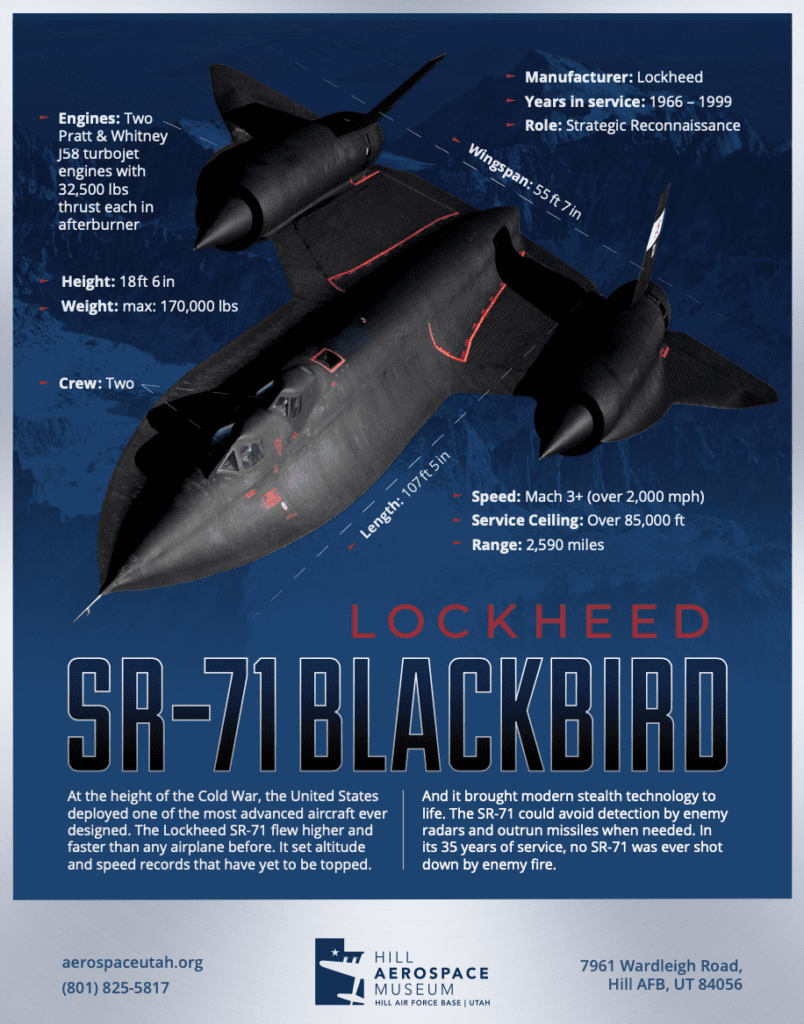Developed during the Cold War under the secretive Skunk Works division at Lockheed to meet increasingly demanding reconnaissance requirements, the SR-71 “Blackbird” broke speed and altitude records that have yet to be broken. It remains the world’s fastest and highest-flying production, air-breathing manned aircraft.
The SR-71C at the Hill Aerospace Museum is one of a kind. There was only one C model Blackbird ever built, and it was the final SR-71 to be manufactured. The model is a hybrid between the rear fuselage of the YF-12A and a functional engine mock-up of an SR-71A forward fuselage built for static testing.
Lockheed SR-71C “Blackbird”
S/N 61-7981
Crew: Two
Engines: Two Pratt & Whitney J58 turbojet engines; 32,500 lbs thrust each in afterburner
Wingspan: 55 ft 7 in
Length: 107 ft 5 in
Height: 18 ft 6 in
Weight: max: 170,000 lbs
Speed: Mach 3+ (over 2,000 mph)
Range: 2,590 miles
Service Ceiling: Over 85,000 ft

The C model made its first flight in March 1969. In September 1970, following flight testing, it was delivered to the 9th Strategic Reconnaissance Wing at Beale Air Force Base. The aircraft only logged 556.4 flight hours, not including the 180.9 flight hours accumulated from the YF-12A, and completed its final flight in April 1976, then was removed from flying status in June 1976. The aircraft was then moved into long-term storage at the Lockheed plant in Palmdale, California.
Utah Senator Orrin G. Hatch intervened and the Hill Aerospace Museum was assigned the aircraft in April 1990. Planning to move the SR-71 from California to the Hill Aerospace Museum began immediately, and members of the Air Force Heritage Foundation of Utah, the 67th Aerial Port Squadron and the 405th Combat Logistics Support Squadron traveled to California to decide the best way to disassemble, package and transport the aircraft back to the Hill Aerospace Museum.
In August of 1990, the aircraft was broken down into three major pieces and sorted into smaller components for transport on a C-5 Galaxy. When the disassembly was completed, there was no cargo aircraft immediately available to transport the aircraft. In the Spring of 1991, representatives from the 67th Aerial Port Squadron and 405th CLSS traveled twice with large, flat-bed trucks to transport most of the palatalized components, leaving only larger components that required to be moved by a cargo aircraft. In August 1991, the final transport was arranged.
It was a two-month process to reassemble the SR-71C model, but thanks to the 405th CLSS, Volunteers, Air Force Reservists and many active-duty personnel, the aircraft was ready for display. In October 1991, the SR-71C was placed on display at the Hill Aerospace Museum.
